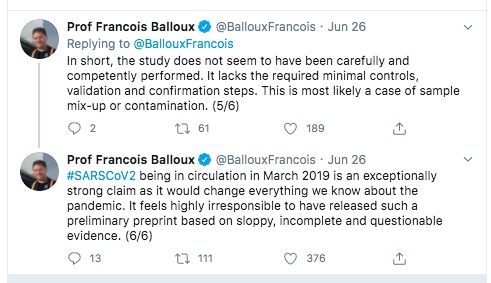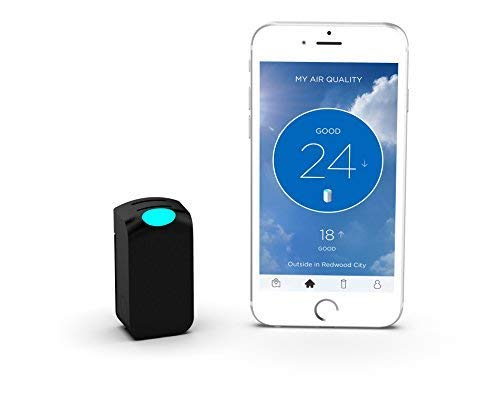; Date: Sat Jul 25 2020
Tags: Coronavirus »»»»
The official story of the origin of COVID-19 (SARS-nCOV-2) is an origin in a Wet Market (market where live exotic animals are sold) in Wuhan China, and that the virus made a jump from Bats to Humans. They eat bats in China, by the way. According to this Oxford Univ researcher, samples of COVID-19 RNA were found in samples from the Barcelona sewage system in March 2019, and other sewage systems in Europe a little later. That indicates an earlier spread of the virus and raising doubts about the official story.

One big consideration of this video report is that it was published by China Global Television Network, or CGTN. It is unknown whether the Chinese government controls this organization or has any editorial control over what they say.
The researcher interviewed here conducts "meta studies". This means he gathers up data from many individual studies, to generate a more complete picture by combining multiple sets of data.
During the interview he claims that sampling from the sewage treatment system in Barcelona showed the presence of COVID-19 RNA as early as March 12, 2019. That's 9 months before the officially recognized outbreak occurred in Wuhan China. If this report is accurate, where did that COVID-19 RNA come from, and why wasn't there a recognized outbreak in Barcelona at that time?
What he's referring to is a technique long practiced in the epidemiology field of studying samples from sewage systems. Humans who have a disease will poop out pathogens from the disease, which will be collected in sewage treatment plants. That means someone can study sewage samples to get a sense of how wide-spread a disease is by how much of the pathogen is in the sewage samples. Epidemiologists do this all the time as a way to gather data about disease spread in a locality.
This technique does not identify individuals who have a disease. It identifies trends roughly indicating how many people in the area served by that sewage system are diseased.
For example in
Presence of SARS-Coronavirus-2 RNA in Sewage and Correlation with Reported COVID-19 Prevalence in the Early Stage of the Epidemic in The Netherlands, we read about a study of sewage samples of several cities and the airport in the Netherlands. Detection of SARS-CoV-2 RNA preceded the first certified COVID-19 case in the Netherlands by a few days (March 2020). As the number of cases grew in the population the amount of RNA detected this way increased. This particular report supports the official timeline of the COVID-19 outbreak, and the primary purpose is demonstrating how useful it is to screen sewage plant samples for pathogens.
In
SARS-CoV-2 has been circulating in northern Italy since December 2019: evidence from environmental monitoring we learn that a similar sampling in Northern Italy found SARS-CoV-2 RNA in sewage as early as 18 December 2019 in Milan. The first COVID-19 case in Italy was documented on February 21. This indicates the virus was circulating in northern Italy at least 2 months ahead of the first documented illness. The paper linked here is on a preprint server meaning that the paper hasn't completed peer review and has not been published in a regular journal.
In
Was coronavirus really in Europe in March 2019? is an examination of a report from researchers in Barcelona,
Sentinel surveillance of SARS-CoV-2 in wastewater anticipates the occurrence of COVID-19 cases, and
Detecten el SARS-CoV-2 en aigües residuals recollides a Barcelona el 12 març de 2019. That report is the source of the claim that SARS-COV-2 RNA was detected in Barcelona sewage on March 12, 2019. That's 9 months before the official outbreak in December 2019 in Wuhan China.
In the Barcelona case, researchers had available stored sewage samples going back to January 2018. Researchers found evidence of the virus on January 15, 2020, 41 days before the first official case was declared on February 25, 2020. Prior to January 15, 2020, the only positive result was on March 12, 2019. All other samples showed negative for the virus.
This is the data the Oxford researcher mentioned in the interview. However, the result is not verified and again has not gone through peer review. It is possible there is a testing error of some kind. For example the sample may have been contaminated, or possibly other problems. The article suggests one possibility, namely that the researchers were screening for three genes, and that other RNA or DNA fragments may have looked like the gene which was detected.

This researcher, Professor Francois Balloux from University College London, suggests that the March 12 2019 result is shaky and should have gone through more scrutiny before being published.
However, the December 18, 2019 date in Milan Italy is less questionable since it more closely correlates with the known evidence about COVID-19. Even that date predates the official outbreak in China.
Summary
One thing to draw from this is the possibility that a Chinese news network is pushing propaganda in order to deflect the fingers pointing at China. As it stands the whole world is blaming China for this virus. But if COVID-19 was widely circulating long before the outbreak in China, that throws doubt on the whole origin story. Maybe it did not originate in Wuhan China, but came from somewhere else. At least, China's interests would be served if we were all to start believing this possibility.
Until the Barcelona result is verified, we cannot trust that it is accurate. Unfortunately it looks like a lot of news outlets went ahead and ran stories saying that COVID-19 samples were detected in Barcelona in March 2019, never mind that the result is not verified.
Still, the detection of a sample in December 2019 in Milan starts to throw doubt on the story. That result is probably more reliable. It seems that to get a detectable sample in sewage, there must be fairly widespread community transmission. Meaning, for it to show up at the sewage plant, there must be enough people in the locality pooping the virus. Presumably most of them were presymptomatic (did not yet show symptoms), or asymptomatic (never showed symptoms), and those who'd gotten sick may have been labeled as having a severe Flu.
That would indicate an arrival in Milan much earlier than December 18, 2019. So... where did it come from? It's not yet known, is it?









